Summary
Natural fractures associated withkarst systems certainly exist in a tight Devoniancarbonatereservoir of the study field withprimary porosity and permeability typically less than 3% and 1mD, respectively. Up to now, several workflows have been implemented to model natural fractures and karst networks; unfortunately, existing results cannot be used for managing the field in the future. This paper presents anewintegratedapproachtobuildthe 3Dgeologicalmodelandsimulationfor Devoniancarbonatereservoirsbasedongeology, geophysics and production data.
With two kinds of reservoir porosity (primary and secondary porosity), the conventional stochastic pixel-based method is applied to populate the porosity and permeability distribution ofmatrix while the objective-based method is used to model vuggy affected cells along fractured zones which were defined from seismic curvature attributes. The properties of fracture corridors are predicted from the power law function of core, well and seismic data, which are consequently modelled by the Discrete Fracture Network (DFN) method and upscaled by ODA’s method. The approach reflects better in matching based on 5 years of production and pressure history. Finally, various development scenarios are investigated.
Key words: Carbonate reservoir, fracture modelling.
1. Introduction
Natural fractures and karst networks significantly influence hydrocarbon production. Especially in this field, natural fracture networks associated with karst features existed in Devonian carbonate reservoirs such as IV, IIIa and III interval (Figure 1) based on core, BHI and production data. Fractured reservoirs are extremely hard to characterise, model and simulate due to the heterogeneity and irregular distribution of fracture properties and karst networks within the matrix background [1]. From a static point of view, the three-dimensional variability of the fracture networks associated with variations of matrix properties is a key parameter to assess. From a dynamic point of view, the large difference in flow behaviour observed between nearby wells should be understood to build predictive simulation models.
According to the heterogeneity of fractured reservoirs, any characterisation study should conclude analysis and close incorporation of multi-scale data of various origins [2]. In this paper, we describe such an integrated approach, from geology, geophysics to reservoir engineering, for the characterisation and modelling of natural fracture networks occurring in a Devonian carbonate reservoir of the field in Russia. The reservoirs are tight carbonnate with matrix porosity and permeability less than 3% and 1mD but extremely high permeability of 5 - 10D estimated from well test and production data, emphasising the importance of natural fracture networks on production.
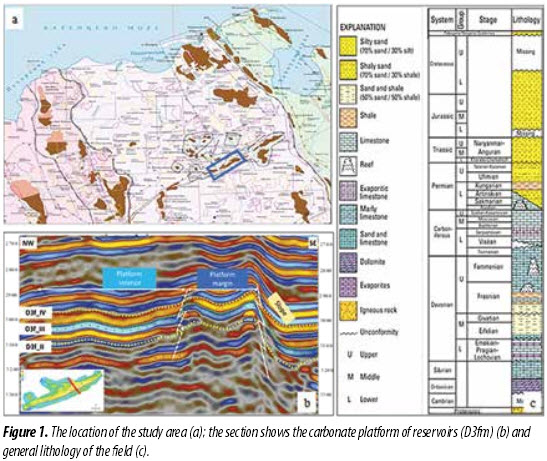
2. Database and methodology
The available data sets in this study include 3D seismic data of depth domain, 96 wells with full log curves, FMI (36 wells), conventional core images (5 wells) and the results of the well interpretations and production data. The 3D seismic data covering a fulfill study area are of good quality with inline and crossline spacing of 25 x 25m. The seismic curvature attributes were used to interpret and predict distribution of faults and large fractures.
The main task of the effort presented was to build a representative, multi-scale fracture model of the reservoir. This implied a correct assessment of the components of fracturing (large-scale fracture corridors, sets of small- scale diffuse fractures), their properties (orientation, dip angle and density; aperture and conductivity) as well as their possible variability. This was achieved through an integrated workflow combining the analysis of geological, seismic and dynamic data. The main steps of the workflow include:
• Indicate a model concept of a depositional environment for each unit reservoir;
• Build 3D geologic model based on seismic, well data, and geologic concepts;
• Fracture analysis from cores, wells and seismic data;
• 3D fracture modelling and upscaling method;
• Build dual-porosity/dual-permeability simulation model;
• Validate model based on agreement with production data;
• Prediction and infill well plans.
The final output of this fracture characterisation and modelling effort was a set of matrix/fracture properties (porosity, permeability) computed in each cell of the simulation grid. Such fracture parameters are uncertain and usually very difficult to assess but are obtained in our methodology as an output of an integrated study whereas many other simulations require them as input parameters.
In a next step of simulation, satisfying a nice match of 5 years producing, and some historical pressures were reached with only minor adjustments of the fracture properties computed, showing the accuracy and adequacy of the fracture model.
Figure 2 presents the sensitive workflow to build up natural fracture networks. The workflow focused on the steps of fracture network modelling.
3. Conceptual geology
From a view of depositional environment, conceptual model plays an important role in constructing the reservoir properties. It helps to understand how lithology develops and how facies distribute in the study area. Based on core samples, the well log interpretation, structural geometry of field through seismic sections and maps as well as references of previous studies, reservoirs are considered as a carbonate platform deposited during Devonian period (D3fm) (Figure 1b). The conceptual model of the depositional environment for each sub-reservoir (Reservoir IV, IIIa and III) has been constructed and described in detail in Figure 3.
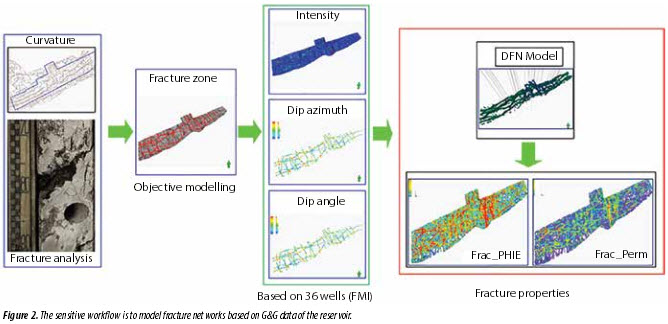
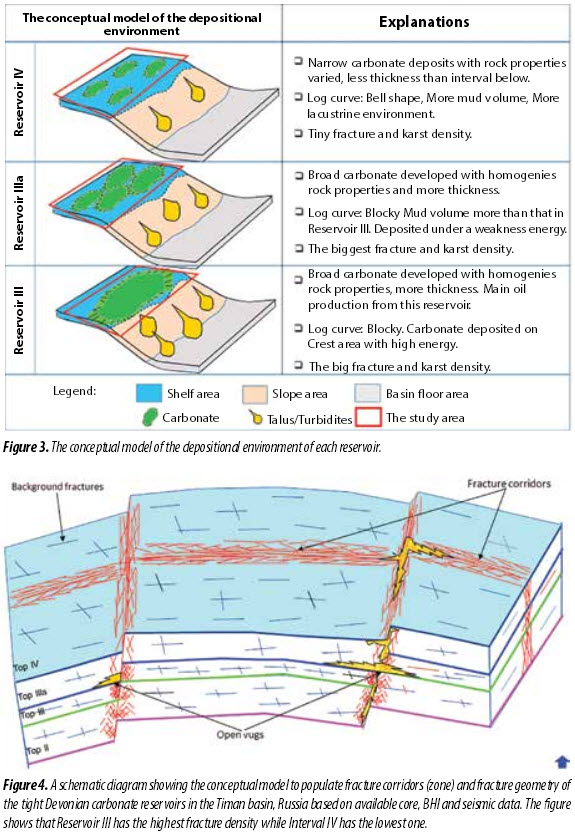
In particular, many ideas to model natural fractures and karst systems in a tight carbonate reservoir are carried out globally. Moreover, each certain concept cannot be applied to all fields effectively. This paper shows a successful conceptual model of natural fracture network for Devonian carbonate reservoirs. The distribution of fractures based on cores, well log, seismic and 5 year-production data was modelled via an objective-based method, which the method was applied to model vuggy affected cells along fractured zones that were defined from seismic curvature attributes. The properties of fracture corridors are predicted from the power law function of well and seismic data, which are consequently modelled by the method of DFN. The ideal model to populate fracture corridors (zone) and fracture geometry is presented in Figure 4.
4. Interpretation and discussion
The reservoir framework has been modelled based on the final seismic interpretations such as main key horizons (Figure 1) and fault systems. In combining with 94 well log data, the reservoir properties of matrix were generated by applying Gaussian Simulation or Sequential Gaussian Simulation Algorithm after completing well log analysis and evaluating variograms of the major/minor and vertical directions. Moreover, water saturation was computedvia Leverett’s Jfunction[3] based on 145 Pc curves from 5 wells of the field, while the permeability of matrix was generated from a relationship between core porosity and core permeability within each layer. With uncertainty of each parameter such as structural maps, facies, petrophysics distribution and oil properties, 200 realisations have been investigated to choose a base- case of the 3D geological model. The base-case is selected to move to next steps for matching and forecasting. Figure 5 illustrates the workflow as well as the base-case properties of 3D geological model.
Cores were available in 5 wells in the field. Their analysis exposed the existence of two main types of natural fractures in the reservoir units (Figure 6): (1) Fracturesrelate to processes occurring during the transformation. They are characterised by small dimensions. These characteristics suggest that they could not have an important impact on fluid flow and, as such, that they are treated as pseudo matrix in the reservoir model in this study; (2) Tectonic fractures, related to the deformation of cohesive rocks under stress. They were frequently observed, with large dimensions and no or partial cementation. These attributes suggest a possible important impact on fluid flow, indicating that tectonic fractures are the natural fractures to be represented in fracture models of the reservoir.
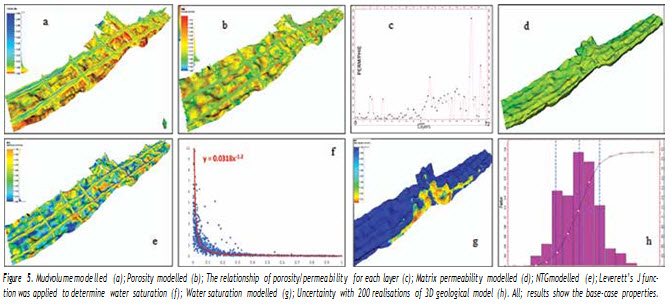
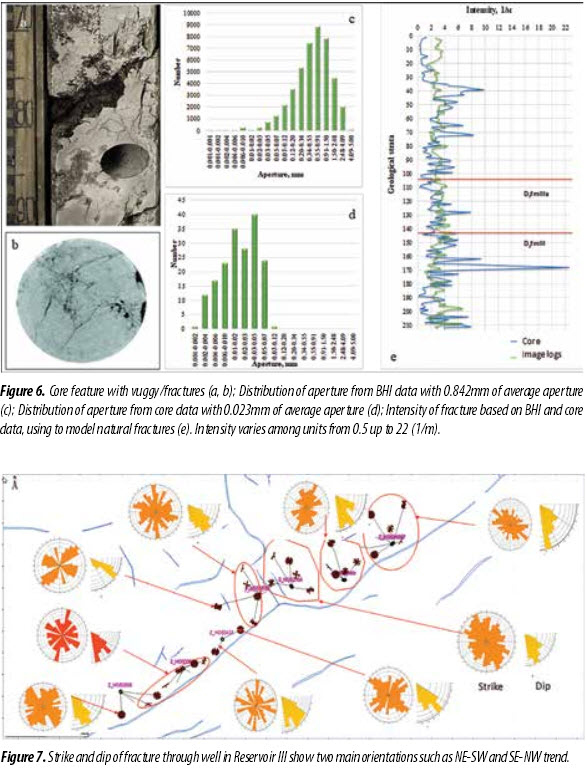
Thirty-six wells with acoustic image logs were available to interpret fractures and only the fractures considered as high or medium confidence features, based on the continuity of their traces on the images, were used for the analysis. Figure 7 demonstrates the strike and dip of fracture through well in the field, in which two orientations
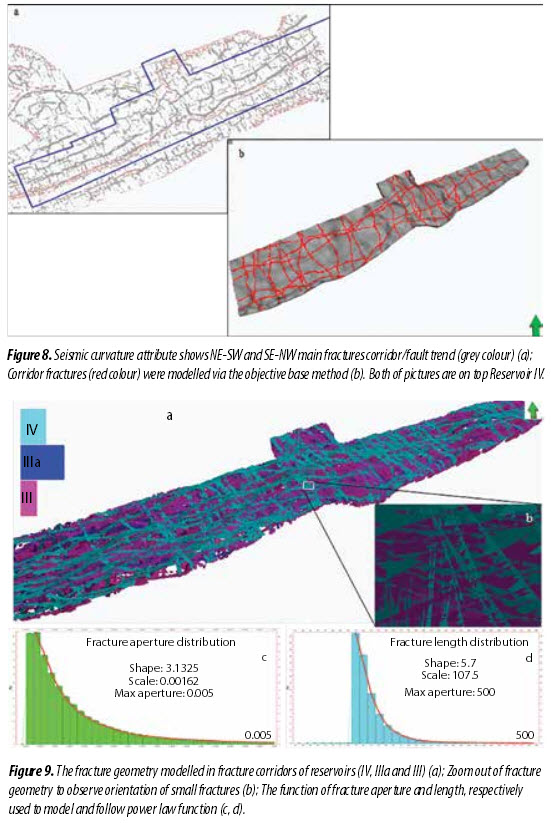
of fracture such as NE-SW and SE-NW trend with dip value similarly can be seen clearly. Intensity, length and aperture of fracture were analysed based on BHI and core data. Figure 8 presents the result of fracture aperture analysis from core and BHI. Generally, the length and aperture of fracture were analysed from core, BHI, outcrops, and seismic attributes under power law function. The intensity of fracture was estimated from FMI through wells in the field. The results of fracture intensity show that Reservoir III has the highest intensity while Reservoir IV has the lowest one. All the mentioned information of fracture has been used to populate and model geometry and properties of fracture shown in later stages.
Seismic data (top horizon, faults and seismic attributes) were used to complete the detection of seismic faults by the identification and mapping of sub-seismic faults which are expected to form fracture corridors. Seismic curvature attribute performed on the top reservoir horizon is done to allow the validation and extension of the seismic faults, and the detection of many new fracture lineaments. These lineaments have NE-SW and SE-NW orientations, consistent with seismic fault orientations. Figure 9a shows all of the large fracture corridors occurring in the reservoir and served as a basis for the modelling of such features.
Once the fracture characterisation was completed, the information obtained in terms of the components of fracturing, their distribution in the reservoir units and their possible dynamic impact was used to build a 3D fracture model using an advanced modelling methodology [2].
As seen in the early stage of fracture analysis, two types of tectonic fractures occur in the reservoir intervals and should be represented in the DFN model: small-scale diffuse fractures with NE-SW and SE-NW orientations, and large-scale fracture corridors. The diffuse fractures were generated using an objective stochastic process based on considering diffuse fracture density established among seismic lineaments. The mean orientation in the fracture sets was interpolated in the 3D grid from values at wells with probability histogramestimated by fracture set based on wells results. Fracture lengths were considered to obey a power law distribution, as observed for larger-scale fracture corridors (Figures 8 and 9). The diffuse fractures were bounded by sub- layers created in each cell of the 3D grid. The DFN model built was controlled in order to check the expected behaviour in terms of fracture density and connectivity.
The modelling of large-scale fracture corridors was based on the interpretation of faults in seismic and
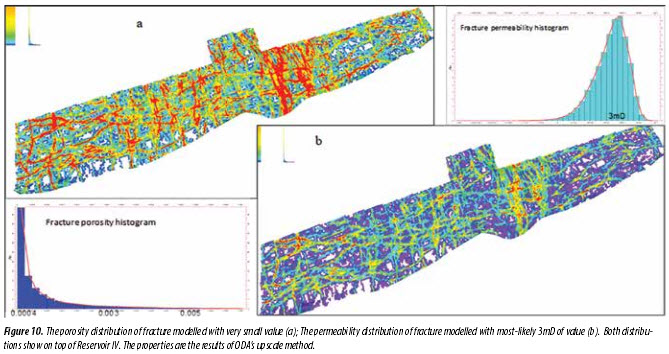
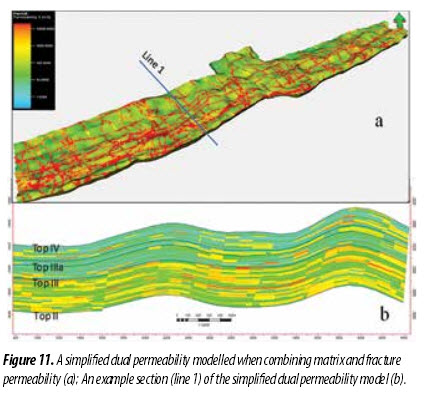
lineaments derived from curvature analysis and seismic facies analysis. The position and geometry of the seismic curvature attribute were used to create fractured zones and tied to well data in the reservoir by objective-based method. These corridors were represented at the center of the fractured zones, cross-cutting all of the layers of the reservoir grid. Figure 9a illustrates the main trend of fractured zones based on the seismic curvature attribute and Figure 9b shows the fractured zones modelled by objective-based method.
When the hydraulic properties of fractures were calibrated in the DFN model, the ultimate task was to compute full field, equivalent properties of the fracture networks to be used in dual-medium simulations. This task consisted in converting a geological image of the reservoir, the DFN model with its complex fracture network architecture, into a simplified dual-porosity model. This simplified conceptual model represents the fractured reservoir as an array of parallel matrix blocks limited by a set of uniform orthogonal fractures [4].
In this study, the fracture parameters were computed from an upscaling of the fracture model by using an analytical ODA’s method. The method is a statistical calculation that estimates permeability, based on the total area of fractures in each cell and their various parameters. It is relatively fast on a limited number of fracture planes but does not take the connectivity of fractures into account and can, thus, underestimate fracture permeability when the intensity is low [5]. Figure 10 illustrates these results by showing the fracture porosity and permeability modelled at the top of Reservoir IV. The storage of fracture is quite tiny, however; the permeability of fracture plays an important role in taking fluid from reservoir to well. Figure 11 presents a simplified dual-permeability model after combining matrix and fracture permeability modelled.
In term of history matching, three factors, which are oil volume, water cut and pressure, are significant issues in simulation. Generally, to reach a good history match of the production data, minor adjustments of parameters such as permeability, aquifer and end point values will be needed.

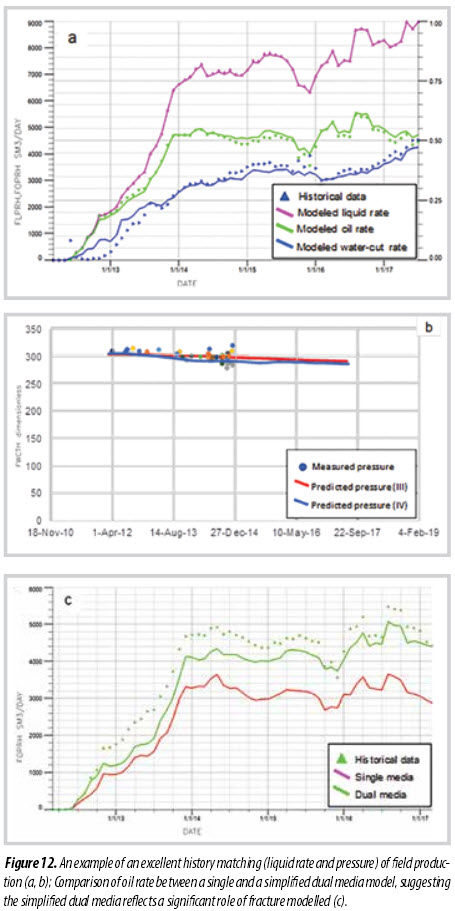
For instance, the simplified dual-permeability of reservoirs was changed locally from 0.1 up to 100 times. Figure 12 (a, b) presents an excellent history matching of the field production. Similar quality matches are obtained for individual wells (84/96 wells) as well. Whereas Figure 12c illustrates comparison between a single and a simplified dual media one, suggesting the confidence of the fracture model developed.
According to agreement of history matching, several field development cases to establish such a waterflood and infill new production wells were used to predict and investigate for the future. A base case of field development (Case A in Table 1) is considered an optimised waterflood plus current producer wells. The results of this case are used to compare to other development cases. As a result, the relative liquid produced of the field among these cases is close to each other with recovery factor varying from 24% to 27%. Table 1 presents the results and description of each development case.
5. Conclusions
As dynamic and static data show a clear positive effect of fractures/vuggy on production, the integrated methodology of geophysics, geology and reservoir engineering was successfully used to model natural fractures associated with karst networks in matching and prediction of the field.
A reasonable good history match is obtained for the oil, water-cut and pressures based on 5-year production. The excellent matching suggests an accurate prediction of the movement of displacement front inside the reservoirs as well as a close approximation in modelling reservoir voidage and depletion.
These conceptual models presented will be useful to apply for other nearby fields in the future.
Acknowledgement
The authors would like to thank the Vietnam Oil and Gas Group and the Vietnam Petroleum Institute for providing data and funding this study and for permission to publish the results. Valuable comments by Dr. Trinh Xuan Cuong helped to improve the manuscript. Suggestions from referees and Editor are greatly acknowledged.
References
1. L.Lonergan, R.J.H.Jolly, K.Rawnsley, D.J.Sanderson. Fractured reservoirs. Geological Society Special Publication 270.
2. B.Bourbiaux, R.Basquet, J.M.Daniel, L.Y.Hu, S.Jenni, G.Lange, P.Rasolofosaon. Fractured reservoirs modelling:
a review of the challenges and some recent solutions. First Break. 2005; 23(9): p. 33 - 40.
3. M.C.Leverett. Capillary behavior in porous solids. Transactions of the AIME. 1941; 142(1): p. 152 - 169.
4. J.E.Warren, P.J.Root. The behavior of naturally fractured reservoirs. Society of Petroleum Engineers Journal. 1963; 3(3): p. 245 - 255.
5. M.Oda. Permeability tensor for discontinuous rock masses. Géotechnique. 1985; 35(4): p. 483 - 495.
6. H.E.Cook, D.V.Alexeiev, V.G.Zhemchuzhnikov, V.Ya.Zhaimina, W.G.Zempolich, A.Ye.Zorin, P.J.Lehmann. Devonian and Carboniferous carbonate platform facies in the Bolshoi Karatau, Southern Kazakhstan: Outcrop analogs for coeval carbonate oil and gas fields in the North Caspian basin. In “AAPG studies in geology: Oil and gas of the greater Caspian area”. 2007; 55: p. 159 - 163.